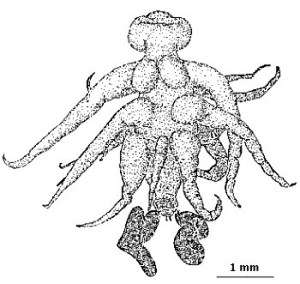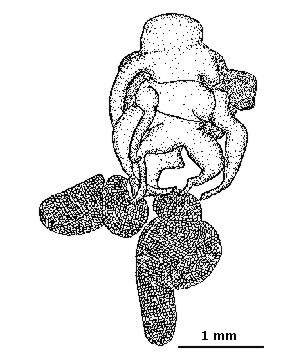

Comparison of Ismalia species
Return to Ismaila in Chile main page.
Females of Ismaila are well-characterized by three pairs of dorsal appendages and an additional unpaired, mediodorsal processus (Jensen, 1987). Both females and dwarf males have two pairs of antennae, an apparently varying number of mouthparts, and several thoracic 'legs' (see Ho, 1981; Belcik, 1981).
Ismaila sp. 1. (UPPER DRAWING)
•Parasitises T. darwini.
•Female body length up to 6,9 mm (n = 67); slender body; long dorsal appendages; Spiral egg sacs;
•Position in host: head and hind-body to the left of the digestive gland; egg-sacs protruding medio-dorsally behind the gill circle.
•Prevalence: 28 % (n = 510); ranging from 0-100 % in certain populations.
•Effects on host: majority of hosts without visible effects; somatic destruction in hosts with
multiple infection (> 2 females/ host).
Ismaila sp. 3 (LOWER DRAWING}
•Parasitises Flabellina sp. 1.
•Female body length up to 3,4 mm (n = 31); stout body; short dorsal appendages; spiral egg sacs.
•Position in host: head anterior to pericard, hind-body usually posterior to pericard; egg-sacs protruding between host cerata.
•Effects on host: gonadal tissue in almost all specimen reduced or absent; destructive effects independent of intensity of infection.
Michael Schrödl
If you have specimens or information on similar animals from anywhere in the world, please let Michael know at:
schroedl@zi.biologie.uni-muenchen.de
Rudman, W.B., 1999 (September 7) Comparison of Ismalia species. [In] Sea Slug Forum. Australian Museum, Sydney. Available from http://www.seaslugforum.net/factsheet/ismaila2
